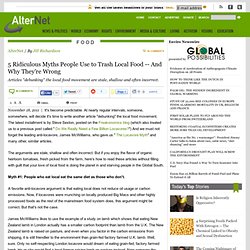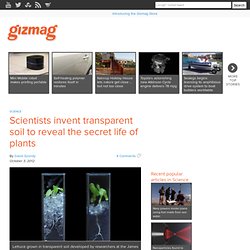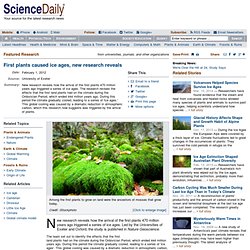

Don't define me. Flowers Communicate with Electricity. MIT creates solar cell from grass clippings. A researcher at MIT, Andreas Mershin, has created solar panels from agricultural waste such as cut grass and dead leaves.

In a few years, Mershin says it’ll be possible to stir some grass clippings into a bag of cheap chemicals, paint the mixture on your roof, and immediately start producing electricity. If you remember high school biology classes, you will hopefully remember a process called photosynthesis, whereby plants turn sunlight into energy. 5 Ridiculous Myths People Use to Trash Local Food. November 18, 2011 | Like this article?

Join our email list: Stay up to date with the latest headlines via email. It's become predictable. At nearly regular intervals, someone, somewhere, will decide it's time to write another article "debunking" the local food movement. The arguments are stale, shallow and often incorrect. Myth #1: People who eat local eat the same diet as those who don't. A favorite anti-locavore argument is that eating local does not reduce oil usage or carbon emissions. James McWilliams likes to use the example of a study on lamb which shows that eating New Zealand lamb in London actually has a smaller carbon footprint than lamb from the U.K.
Myth #2: The only reason for eating local is reducing 'food miles.' Amazonian Mushroom Eats Indestructible Plastics. Yarrow: Ancient Insect Repellent. (Before It's News) Image: University of Wisconsin If you plan on spending time outdoors this summer, then yarrow, Achillea millefolium, is a very useful herb to know about.

As the title of this post suggests, you can make an alcohol extract of the upper parts of the yarrow plant — the leaves and flowers — and spray it as an insect repellent. (The recipe is one part herb per two parts liquid menstruum, which should be 50% alcohol). Yarrow has other applications, too. Wikipedia Image. Steroids control gas exchange in plants. Public release date: 5-Feb-2012 [ Print | E-mail Share ] [ Close Window ] Contact: Zhiyong Wang zywang24@stanford.edu Carnegie Institution Stanford, CA— Plants leaves are sealed with a gas-tight wax layer to prevent water loss.

If plants generate magnetic fields, they’re not sayin’ A titan arum nicknamed "Trudy" is fully opened after flowering in June 2009 in the UC Botanical Garden. Two sensors of a magnetomer are visible to the lower left. (Eric Corsini) Lichens. 7 Edible Weeds - Article. What You Eat Affects Your Genes: RNA from Rice Can Survive Digestion and Alter Gene Expression. Breaking News: Monsanto To Face Biopiracy Charges In India. An farm worker assorting eggplants in the Indian state of Gujarat. by Arne Hückelheim/WikicommonsAccording to an article published this month in the journal Nature Biotechnology, Monsanto is facing biopiracy charges in India.

In an unprecedented decision, India's National Biodiversity Authority(NBA), a government agency, declared legal action against Monsanto (and their collaborators) for accessing and using local eggplant varieties (known as brinjal) to develop their Bt genetically engineered version1 without prior approval of the competent authorities, which is considered an act of "biopiracy. "2 The journal of Nature Biotechnology reported: Scientists invent transparent soil to reveal the secret life of plants. Lettuce grown in transparent soil developed by researchers at the James Hutton Institute and the University of Abertay Dundee in Scotland Most people’s image of plants is actually upside down.

For most of our photosynthetic friends, the majority of the plant is underground in the form of an intricate system of roots. The bit that sticks up is almost an afterthought. That’s a problem for scientists trying to study plants because growing them in media that allow you to see the roots, such as hydroponics, doesn't mimic real soil very well. Now, a team of researchers at the James Hutton Institute and the University of Abertay Dundee in Scotland has developed an artificial transparent soil that allows scientists to make detailed studies of root structures and subterranean soil ecology on a microscopic level. Dutch PlantLab Revolutionizes Farming: No Sunlight, No Windows, Less Water, Better Food. +92 more posted on Aug, 14 2011 @ 01:55 PM I always enjoy innovations such as this and thought this would be good to share in the spirit of hope regarding food issues and potential shortages.

The Dutch have developed a program that is super efficient and maximizes every single aspect of a plant and it's characteristics to provide a perfect plant, with optimum results. Newly Discovered Plant Bows Down and Buries Its Own Seeds. Why the hottest chilies grow in the wettest places. Lettuce-Bot can kill weeds with 98% accuracy. Honeybee deaths linked to seed insecticide exposure. Honeybee populations have been in serious decline for years, and Purdue University scientists may have identified one of the factors that cause bee deaths around agricultural fields.

Analyses of bees found dead in and around hives from several apiaries over two years in Indiana showed the presence of neonicotinoid insecticides, which are commonly used to coat corn and soybean seeds before planting. The research showed that those insecticides were present at high concentrations in waste talc that is exhausted from farm machinery during planting. Unlocking the fractal patterns in cauliflower. How many plants would you need to generate oxygen for yourself in an airlock? Are the tables turning in the war between pests and genetically modified crops? I'm pretty sure they're aware of that fact, the problem is its the only way to produce enough food for a large population.

Without the development of agriculture, humanity would still be relegated to a small population of hunter/gatherers. Not really. We could sustain 10 billion with crop rotation pretty easily. It's just that the agricultural markets and government subsidies are heavily skewed in favor of cash crops. That's why the US produces a zillion tons of corn nobody wants so they have to keep inventing new ways to use it, like fructose corn syrup, corn based biofuels, paper made out of corn, building materials made of out corn, people made of corn and so on. First plants caused ice ages, new research reveals. New research reveals how the arrival of the first plants 470 million years ago triggered a series of ice ages.

Led by the Universities of Exeter and Oxford, the study is published in Nature Geoscience. The team set out to identify the effects that the first land plants had on the climate during the Ordovician Period, which ended 444 million years ago. During this period the climate gradually cooled, leading to a series of 'ice ages'. This global cooling was caused by a dramatic reduction in atmospheric carbon, which this research now suggests was triggered by the arrival of plants. Among the first plants to grow on land were the ancestors of mosses that grow today. Discovery on how sugars are moved throughout a plant.
Food prices are soaring at the same time as Earth's population has just reached 7 billion. As a result the need for increased crop yields is extremely important. New research led by Carnegie's Wolf Frommer into the system by which sugars are moved throughout a plant -- from the leaves to the harvested portions and elsewhere -- could be crucial for addressing this problem. Their work is published December 8 by Science Express. Just as it's necessary for the human body to move nutrients to all of the organs, it is vital for green plants to transport sugars to supply its various parts. Key mechanism that regulates shape and growth of plants discovered. UBC researchers have discovered a key mechanism that -- much like a construction site foreperson -- controls the direction of plant growth as well as the physical properties of the biopolymers that plants produce.
The finding is a major clue in a 50-year-long quest to explain how plants coordinate the behaviour of millions of cells as they grow upward to compete for light, penetrate soil to obtain nutrients and water, and even open petals to flower. "We've known for decades that structures in plants called microtubules act as scaffolding to define the direction of cell expansion," says Professor Geoffrey Wasteneys, a UBC botanist and Canada Research Chair in Plant Cell Biology. "These are tiny multipurpose cylinders that grow, shrink and self-organize to transport cargo, capture and position large structures such as chromosomes, and establish the shape of cells. But we haven't been able to determine how these tiny microtubules are organized into scaffolds in the first place.
" Earliest known bug-repellant plant bedding found at South African rock shelter. Rare finds such as early ornaments, cave drawings and Middle Stone Age engravings are the subjects of a good deal of anthropological study and they provide clues. But in the journal Science, an international team of researchers report another find that could give additional insight. Strawberries Protect The Stomach From Alcohol. Electricity from the marshes. An unexpected source of new, clean energy has been found: the Plant-Microbial Fuel Cell that can generate electricity from the natural interaction between living plant roots and soil bacteria. Tiny protein helps bacteria 'talk' and triggers defensive response in plants. Organisms. Experimental Recipes with Azolla, Super Plant (and Future Space Food?) Logy Magazine.
No sun, no problem: scientists discover dark secrets of the plant world. The dark secret of plants ... revealed. Purple lights and math help PlantLab grow food more efficiently. Plants Use Body Clocks to Prepare for Battle. Anthropology in Practice. Chili peppers. Plants create a water reserve in the soil. Plant Teacher - Entheogens and Healing Herbs.
Digital inventory of medicinal plants underway in Pune - Mumbai. Nitrogen Fixation. Urban Physic Garden. PlantLab. Horticulture Discotech: LED Grow Lights Power Sustainable Farming. Plants Clean Up More Air Pollution Than Previously Thought. Scientists Discover First Night-Flowering Orchid : The Two-Way. Flowers in Ultra-Violet. Pests Are Developing Resistance to Monsanto's Engineered Supercorn. Inside Insides. All he is saying, is give pee a chance. Tip of the Tongue: The 7 (Other) Flavors Humans May Taste. Leafy social network: Scientists study how stomata communicate. How the first plant came to be. The ISME Journal - Endogeic earthworms shape bacterial functional communities and affect organic matter mineralization in a tropical soil. Plants and fungi play the 'underground market'
Guide to Common Edible Wild Plants.